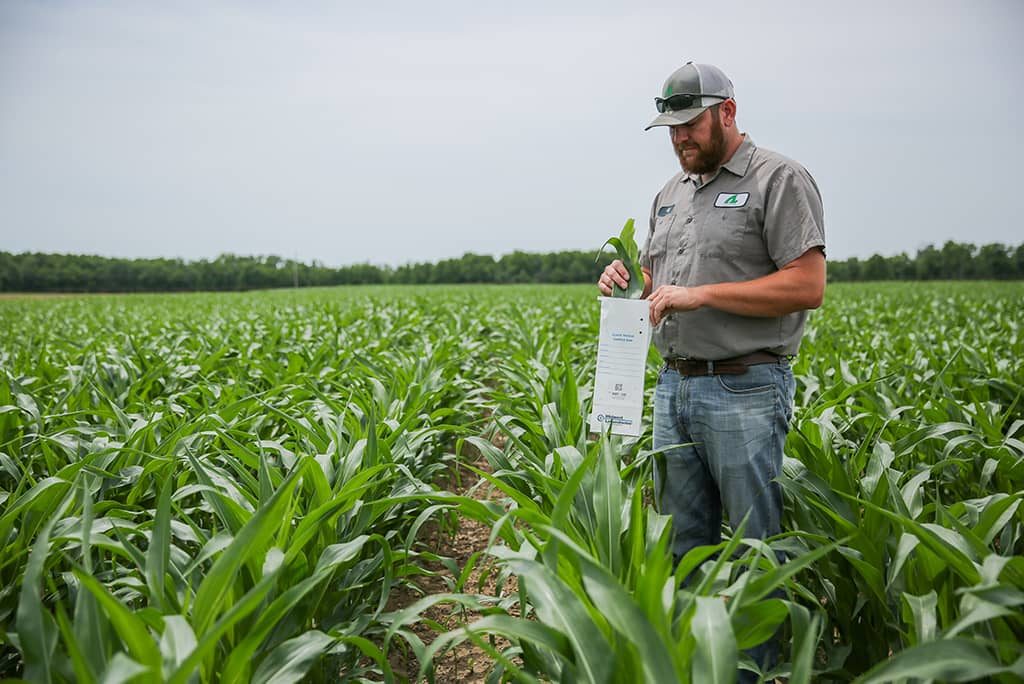Soil Testing & Tissue Sampling
Taking the Guesswork out of Crop Nutrition
Soil testing and tissue sampling are key to developing the optimal crop nutrition program. If you don’t know what nutrients your soil contains, and you don’t know how plants are or aren’t absorbing them, then how do you know if you’re providing the right nutrients? Soil testing and tissue sampling take the guesswork out of this process. Let us review your soil test analysis with you to help develop the right crop nutrition plan for your operation.
Soil Testing
Soil testing is the first step in determining the optimal nutrition program. A soil test can tell you a lot about the soil conditions at your farm, including nutrient levels, pH, base saturations, organic matter, and cation-exchange capacity (CEC). All of these factors play a role in how your plants absorb water and nutrients, whether those nutrients are usable in the soil, and the biological activity determining the soil health.
A soil test can answer a lot of questions you may have about your corn, soybeans, potatoes or other crops. Different nutrient deficiencies often appear in similar ways, so it can be difficult to tell what the problem is. For example, corn deficient in phosphorus can turn purple at the leaf margins, but this can also be caused by early cold weather. If your crops are showing stunted growth, discoloring or curling at the margins, a soil analysis can tell you if nutrient deficiencies are to blame. With this information, you can correct the problem and stop it from happening again. A soil test can also tell you what nutrients or additives can help you increase yield. For example, low levels of some micronutrients can decrease utilization of other macronutrients. The crops will still be productive, but not as productive as they could be.

Benefits Soil Testing
- Reveal nutrient deficiencies causing stunted growth
- Show soil pH and impacts on nutrient profiles
- Show biological activity and the impact on nutrient retention
- Show CEC, soil quality, and possible improvements
- Show ways to increase yield
How do I gather a sample for a soil test?
Gathering samples for soil testing isn’t complicated, but it must be done with care. This ensures your soil test accurately represents the area you’re testing.
Follow these instructions to get the most accurate soil test possible ›
1
Pull soil samples in a zig-zag pattern through the middle of the area, or use a grid pattern.
2
Pull separate soil samples for areas that show crop damage, different soil types, or different water absorption patterns. Each composite sample should not represent an area larger than 20 acres.
3
Place soil samples in a clean plastic bucket that is not used for any other purpose. Metal buckets and residue on the bucket will corrupt the sample.
4
Send the soil samples to the address provided with your test bag.
5
Wait for the results!
Tissue Sampling
Soil testing will reveal the health and nutrient profile of the soil, but it won’t show how plants actually absorb these nutrients. A number of factors can affect nutrient absorption in plants, and this won’t be clear from a soil sample. This is where tissue sampling comes in. A plant tissue sample will show what nutrients the plant has absorbed and the movement of nutrients throughout the plant.
A tissue test combined with a soil test is the best way to see what is really going on at your farm. A tissue test will not only show how the plant is absorbing and using nutrients, but it will also show you if damaging organisms are affecting your plant, disease has set in, or if the plant’s root growth is insufficient for nutrient absorption. This way, you can get the full picture of the plant’s environment, and its reaction to that environment.

Benefits of Tissue Sampling
- Reveal issues with nutrient absorption
- Show diseases or fungus affecting plants
- Show nutrient movement and sugar processing
- Show stunted root growth
How do I gather a sample for a tissue test?
Like soil sampling, gathering a tissue sample is not complicated, but it must be done with care.
Follow these steps to gather your tissue sample ›
1
Sample plants using a grid pattern or zig-zag throughout the area. You’ll need a seperate sample for each 20 acre area.
2
Sampling methods will depend on the age and type of the plant. For older plants, take the most recently matured leaves (for a crop like corn), or the upper third of the plant (for a crop like alfalfa). It’s a good idea to take at least three samples from each part of the grid or zig-zag.
3
Be sure to collect clean plants without mud splash, and place them in the sample bag or in a clean plastic bucket. Mud, residues, or metal buckets can disrupt the sample.
4
Mail the tissue samples using the bag and address provided.
5
Wait for the results!
Have a specific crop problem you’re trying to solve?
AgroLiquid was founded because there wasn’t a nutritional product that was solving our fertilizer needs; now after 35 years our chemists and biologists continue to innovate and create the best products on the market. If you have a specific crop or soil problem, ask one of our agronomists and we’ll help you solve it!

